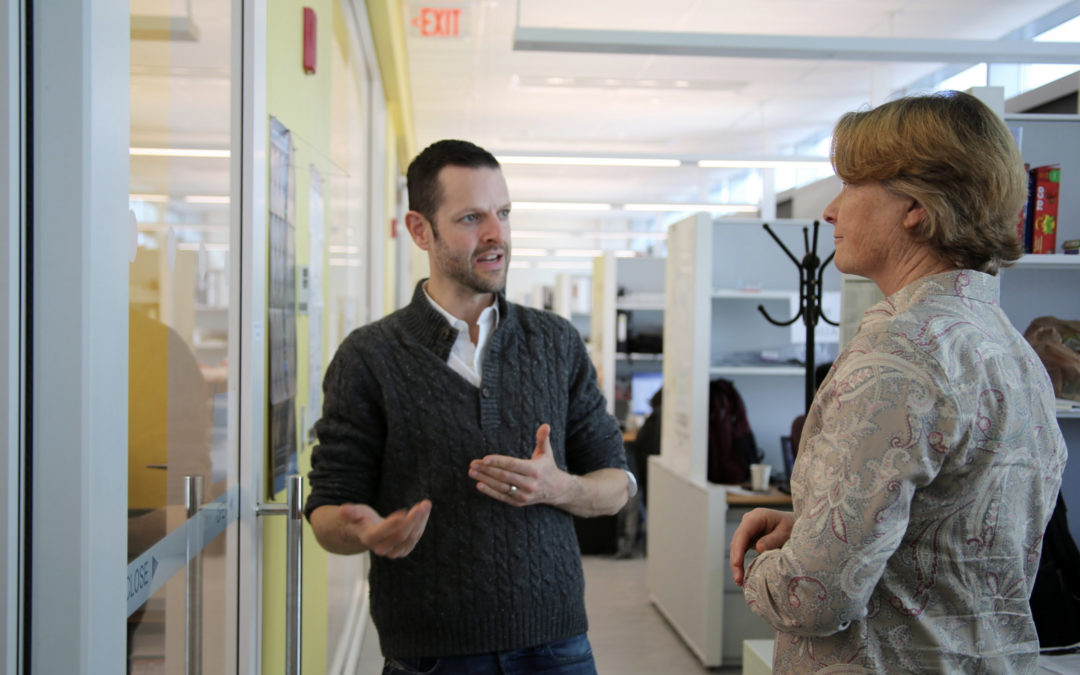Last Thursday, the Biomimicry Institute hosted a webinar on nature-inspired medical technologies with Dr. Jeffrey Karp and Dr. Alexandra Ralevski. In this conclusion of the 3-part series on bioinspiration in biomedicine, we dive deeper into conversation with Dr. Karp on his approach to problem solving and creating an environment of empowering action.
At the intersection of nature and innovation rests the opportunity to create a safer, smarter, and healthier society. Good health and wellbeing guide our everyday activities. The doctors and physicians who have dedicated their lives to the care of others allow us to live with comfort for our bodies and our minds. From the everyday to the sickest days, medicine is both a science and an art; and at its core, a relationship between people built on trust. It is for advancing this relationship that those designing the future of medical care find practical inspiration from nature.
Dr. Jeffery Karp, a biomedical engineer and serial entrepreneur, has embraced this mission with a transformative approach to biomedicine. His work as Professor of Medicine at Brigham and Women’s Hospital bridges science, medicine, and business development. His lab unites physicians, engineers, and biologists to create a powerfully creative team. Last week, the Biomimicry Institute’s Science Director Dr. Alexandra Ralevski ‘sat down’ with Dr. Karp to discuss effective problem solving from idea to implementation. Effective communication was a central theme, both in the context of collaboration in research as well as helping the public connect with science.
It began by chance.
As a postdoc researcher at MIT, a casual glance at a journal introduced Dr. Karp to a gecko-inspired adhesive that would catalyze his career into bio-inspired biomedical technology. Today, his unique lab has produced medical devices and techniques ranging from porcupine-inspired surgical staples to sandcastle-worm glue for repairing hearts. Over thirteen years, $400million in funding, and ten companies later, Dr. Karp has been able to successfully bring such products to market where they can make an impact on patients’ lives.
Sharing the goal of his lab to Dr. Ralevski, and over 500 nature-inspired enthusiasts from around the world, Dr. Karp explains how, “a powerful thing we can do as academics is not just publish papers and journals, but rather set things up so that we can maximize the potential to help patients in the shortest period of time.” A key factor in optimizing this translational success has been Dr. Karp’s attention to building an environment of empowerment with “free-flowing ideas,” and a process for “making mistakes where people can learn from those mistakes.”
Unlike most traditional research groups, the Karp Lab is home to experts from multiple disciplines ranging from chemistry and biology to cardiovascular surgeons and gastroenterologists. Dr. Karp elaborates on how this minimal overlap of expertise adds value in problem solving andallows “everybody to bring a unique perspective.” Validating his colleagues at the individual level removes typical barriers to advanced discussions.
This creates a space where no two days will be the same. Ranging from tissue adhesives or cancer therapies to surgical devices, the lab is in constant motion for advancing the role of biomedicine in healthcare. The research team benefits from a dynamic exchange of collaboration, rather than competition, for their many ongoing projects. A diversity of thought and experience defines the Karp Lab as its own community in the ecological sense. In nature, each member plays a role in the balance of a functioning ecosystem through social and situational interactions. For research at the university level, pursuing this balance increases productivity and drives a sense that everyone is a valued addition to the team.
He looks for ways to empower others through opportunities of different experiences.
Stepping aside to give someone else a platform for new experiences is a powerful way to purposefully support others. Dr. Karp says one moment that showed him this was letting a PhD student take a leading role in writing grants for funding. Not only was this helpful in overcoming the learning curves of the industry, but it also gave rise to a confidence for them to take the next step in successfully presenting to a group of investors. Seeing how empowering others could lead to success confirmed his view of opening doors for others through supportive freedom.
One key lesson Dr. Karp emphasized was that you don’t have to be an expert, but if you get yourself in the right environment, and approach things from curiosity, passion, and purpose, you can share a new perspective. He believes that, “the most important thing is to make the right, conducive environment, where people don’t feel judged, and decisions are not based on ego.” By surrounding yourself with people who are excited to work with each other, there is limitless potential for positive outcomes. It starts with a desire to understand how others think and what they know. That’s why Dr. Karp never makes a hiring decision on his own for the lab – he trusts if others are excited about a potential new member, then the fit will be right.
Bringing together a high-level group of experts for an interdisciplinary team presents some friction to sparking initial conversations. There is a reason, after all, why there are distinguished academic spheres for specialities within engineering, biology, medicine, and, of course, business. Each discipline contributes its own approach or framework to problem solving. However, this difference in perspectives is a fundamental reason Dr. Karp’s lab has produced such a powerful impact on biomedicine.
The process of innovation is just as important as the innovation itself. The evolution of a project involves failure, curiosity, and a lot of questioning. A space where ideas can be challenged motivates progress and better attention to details. Learning from failure through a network of support is what keeps progress moving forward, something accelerated by constantly working and reworking with the way a problem is seen through a different set of eyes. “The majority of projects in the lab really start from a problem, and then conducting experiments to gain insights.” Dr. Karp points out that “the goal is to learn, not necessarily to succeed.”
It’s an iterative process that happens with feedback, with open communication at the core of this approach to problem-solving. That’s why Dr. Karp has tried to make a new connection with someone in the entrepreneurial ecosystem every two to three weeks. By partnering early on with someone who has deep business expertise, they can create “more and more momentum.” He builds strength with others where it’s most needed.
Not only does this style of work empower others, but it also engages people in a way that can improve their work itself. For surgeons or physicians, there are many risks to today’s medicine that have yet to be solved. Yet, it’s often difficult to introduce a new method or technology to a field where there’s already proven reliability. That’s where inspiration from nature can help communicate a new frame of interest for medical professionals. It’s a spark of curiosity that brings back the childlike-wonder most people experience with the legitimacy of good science.
For Dr. Karp, it’s about getting the right person in front of you and asking the right kind of questions to reach the root of a problem. During one such conversation for a brain tumor project, asking why patients have such a bad prognosis and what would doctors do to improve therapy prompted a radical discovery that the drugs are not toxic enough to prevent tumor growth. As a result of asking this question, a new approach was developed to combine chemotherapeutics with inhibition of a regeneration pathway.
Communicating ideas, problems, and solutions with others is a process of rediscovery and reflection. While preparing for a presentation or lecture, Dr. Karp says that revising slides helps him refocus his purpose for the projects. Shifting toward better storytelling helps clarify ideas in the lab and makes it easier on the entrepreneurial aspects of biomedical research. Even for the review papers and opinion pieces coming out of the lab, he often encourages people who don’t know much about the scientific topic at hand to be authors. This way “it’s a perspective shift… it’s a reflection of excitement of the learning process and communicating as effectively and clearly in an easily digestible way.” This approach to any kind of work simply relies on a commitment to learning
Advanced biomaterials and therapeutics are complex projects. But Dr. Karp’s approach is to meet this complexity with radical simplicity — that is, to make sure innovation is grounded in the reality of manufacturing and regulations at the start. In the biomedical industry, this is a promising way to optimize funding opportunities and successfully translate research toward patient impact. Ultimately, the projects are based on curiosity — the ideas that will excite him a week, a month, or even a year from now.
There is a capacity for creativity in the commitment to collaboration. This is exactly the environment Dr. Karp seeks to foster in the lab. By establishing a space for ideas to flow and fail, solutions are bound to flourish. ‘Getting unstuck’ in problem-solving is about communicating with others outside of your comfort zones: to be interdisciplinary in a linear world. Demonstrating that this method works, Dr. Karp believes, is to “have your own path of discovery led by curiosity.”
AskNature yourself and discover where your curiosity can lead. This is Part 3 of the series on bioinspiration in biomedicine. Find Part 1 and Part 2 here.
 Isabelle Seckler is a second-year student at Columbia University in New York City. She intends to study sustainable development along with a pre-medical track with the hopes of advancing community prosperity at the intersection of our built and natural environments.
Isabelle Seckler is a second-year student at Columbia University in New York City. She intends to study sustainable development along with a pre-medical track with the hopes of advancing community prosperity at the intersection of our built and natural environments.
Twitter: @IzzySeckler | Instagram: @isabelle.seckler

